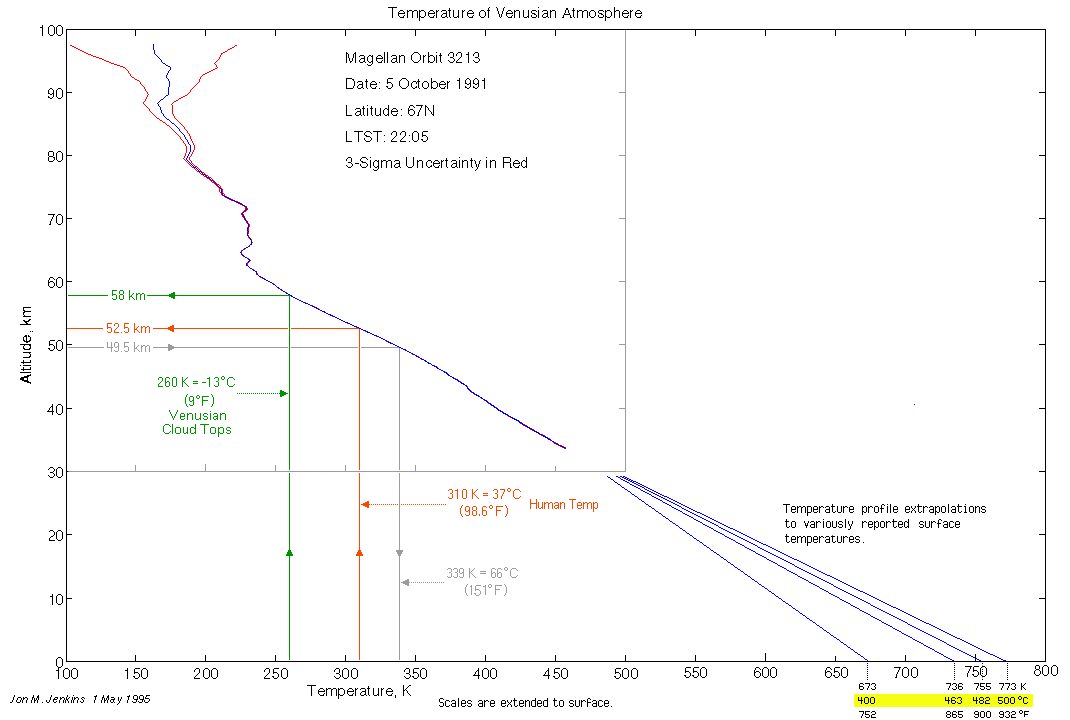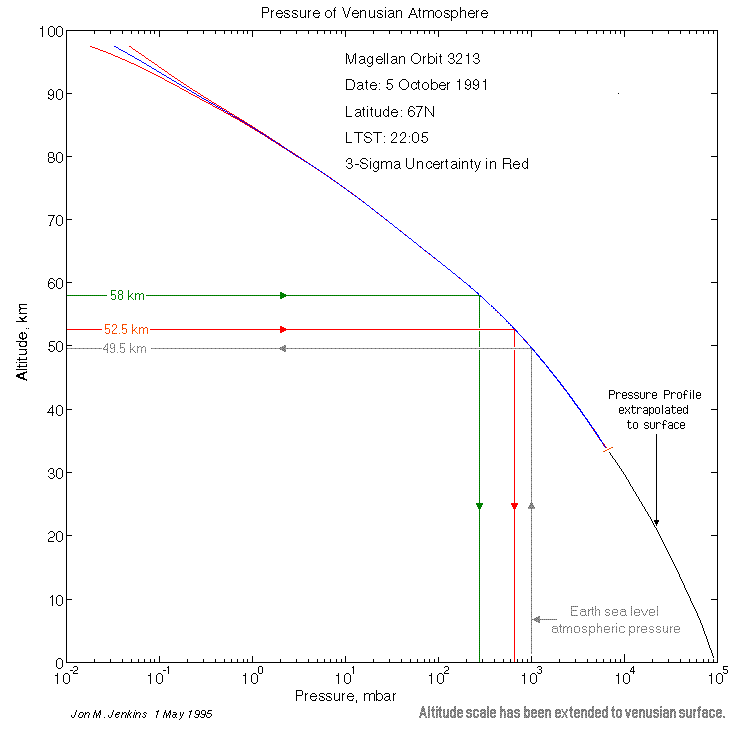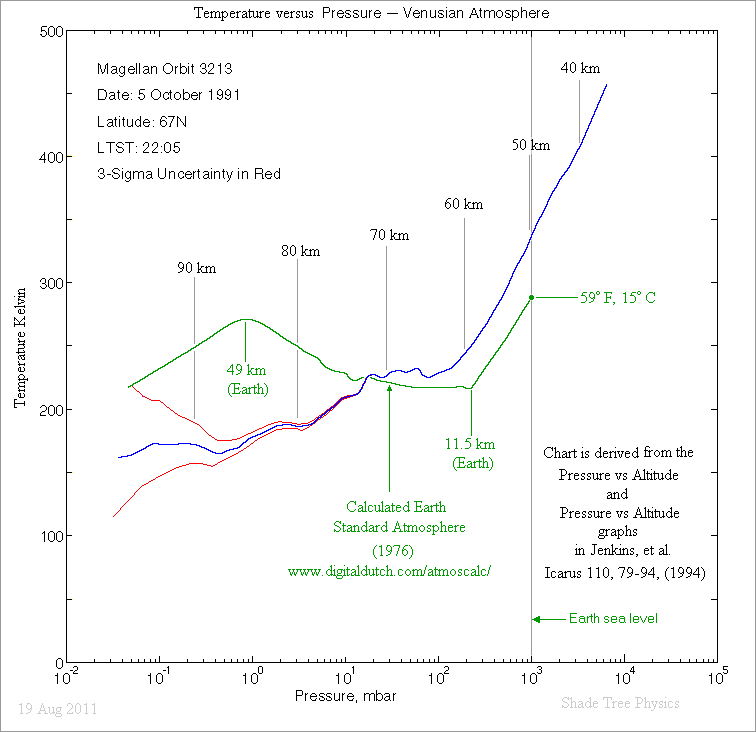
|
Venus Atmosphere Temperature and Pressure ProfilesShade Tree Physics
The URL for this page was previously
Installed 04 Feb 2001 - Latest update 02 Apr 2019.
A reviewer of the article (Influenza 1918, A Venus Connection?) stated that influenza viruses are designed to grow at 37 degrees Celsius [98.6 degrees Fahrenheit] and to replicate using mammalian cell enzymes and that a long period of host and pathogen co-evolution is required. The following graphs are provided as a first step in checking up on whether or not a suitable temperature, pressure, and chemically friendly environment for the production or replication of viruses exists in the Venusian atmosphere.
These first two graphs (before my additions and extensions), were originally
published by J.M. Jenkins, P. G. Steffes, D.P. Hinson, J.D. Twicken, and G.L. Tyler
in their article, Radio Occultation Studies of the Venus Atmosphere with the Magellan
Spacecraft, Icarus, Vol. 110, 79-94, 1994. (The kind permission to use
the graphs does not constitute endorsement of the hypothesis under evaluation
in this article.) See: Other Temperature and Pressure Profiles.
|

|
The stated 37 degrees C (which is the average human body temperature prior to viral attack) corresponds to 310 Kelvin (K) (Celsius plus 273). If we enter the Venus altitude-versus-temperature graph at 310 K and go straight up (red line) to the temperature profile, and then horizontally to the left axis we find a corresponding altitude of 52.5 kilometers (33 miles).
|

|
Now, as a rough cross-check, we enter the Venus altitude-versus-atmospheric
pressure graph at 1000 millibars (the Earth's average sea level atmospheric
pressure) and go up to intersect the altitude-pressure profile line, then
across to the vertical axis where we find the corresponding altitude of
49.5 kilometers (31 miles). This altitude is only three kilometers
(or six percent) different than what we found from the temperature graph.
So, in spite of the surface temperature of Venus being on the order of 864 degrees Fahrenheit, and the Venusian surface pressure being on the order of 90 earth atmospheres, there is a region in the Venusian atmosphere which approximates that of earth at sea level with respect to temperature and pressure. But there may be problems. 52.5 kilometers above the Venusian surface turns out to be in the middle of the Venusian cloud blanket which is made up largely of sulfuric acid droplets. (The cloud bottoms are estimated to be 30 to 35 km above the surface and the tops are estimated to be from 60 to 75 km above the Venusian surface.) This upper altitude limit is perhaps a fuzzy estimate. The cloud tops temperature has been reported to be 260 K (-13 degrees C or 9 degrees F). According to the temperature profile above (green line) this temperature corresponds to an altitude of 58 km (36 miles) for the cloud tops. (For stratus clouds there will be thermal equilibrium between the atmosphere and the cloud tops.) Is this acidic cloud environment good or bad for the formation of viral precursors and/or virus building processes? (a) Do sulfuric acid (H2SO4) droplets in a reducing atmosphere assist or preclude the formation or preservation of amino acids and other RNA building blocks? (b) Can sufficient solar ultraviolet energy penetrate the clouds to this depth? Another factor that must be dealt with is whether or not the Venusian atmosphere near the cloud tops contains the chemical elements (in sufficient quatities) required to build RNA molecules as well as their cellular (bacterial) hosts. The findings from a search for this information will be placed here. Here is a chart showing temperature versus pressure for the Venusian atmosphere. It is derived from the two graphs above.

[Installed on 16 Aug 2011.]
For a follow-on study about terrestrial biological events related Related Links/ArticlesThe Unexpected Temperature Profile of Venus's Atmosophere - European Space Agency [Added 09 Dec 2016.] NASA's plan for an off-world colony: a floating city above Venus - CNN Tech [Added 26 Nov 2014] Wikipedia Atmosphere of Venus J. K. L. Leong, W. W. Schultz, E. Zebovitz, and N. A. Schlamm, System for Studying Uninfected and Virus-Infected Cell Cultures in Hyperbaric Chambers Applied Microbiology, 1973 September; 26(3): 258–263. [Added 10 Nov 2013] A curious cold layer in the atmosphere of Venus - Venus Express - European Space Agency. Chilly layer of air (around -75 degrees Centigrade) at 125 Km altitude. [Added 26 Feb 2013.] An Alternate View of Venus - John Ackerman [Added 3 Jul 2012] Acidic clouds of Venus could harbour life - NewScientist.com 26 Sep 2002.
Chemical that could power microbes is found at Jupiter moon.
[Was at: http://www.cnn.com/TECH/space/9910/01/europa.acid/ - Link no longer works.]
The "signature" for sulfuric acid, found in acid rain and car batteries on
Earth, has been found on Europa. ... Ken Nealson, head of JPL's astrobiology
unit said the acid's presence excited him about the possibility of life on
Europa. ... Bacteria are very good at exploiting chemical energy sources, even
inorganic sources like sulfuric acid, NASA's Mark Anderson said.
Defining Life "We can conceive of chemistries that might occur in sulfuric acid as a solvent as on Venus." Astrobiology Magazine, 5 Aug 2002. Anne M. Rosenthal, Prospecting for Viruses, Astrobiology Magazine, 4 Aug 2002. "Under scalding acidic conditions, scientists wonder, how do life processes function?"
|